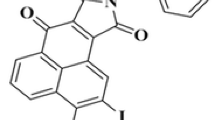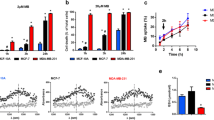Abstract
This study aims to evaluate the photodynamic efficacy of purpurin 18 (pu-18) on triple negative breast cancer both in vitro and in vivo. Two states of 4T1 cells, 2D culture and 3D spheroids, were used to evaluate the photodynamic action of pu-18 in vitro. The in vitro study results indicated that for the 4T1 2D cell culture, the photodynamic therapy (PDT) treatment showed significant photocytotoxicity at low pu-18 concentrations following light irradiation. Pu-18 was found to distribute on the lysosomes, mitochondria, Golgi apparatus, and endoplasmic reticulum. After irradiation, pu-18 can generate ROS to destroy the mitochondrial membrane potential (MMP) and eventually induce apoptosis in the 2D 4T1 cells. Light-activated pu-18 could also induce the destruction of the 3D 4T1 cell spheroids. The in vivo study was conducted by using a subcutaneous 4T1 breast cancer animal model. The results demonstrated that pu-18 could remain in the tumor for more than 4 days by direct intra-tumoral injection. The PDT treatment was performed every 2 days for a total of 3 times. The results showed that PDT treatment could significantly inhibit tumor growth in vivo, indicating a good photodynamic efficacy of pu-18 in the mouse breast cancer model, without influencing weight and major organ function. The survival pattern results showed that PDT treatment could largely extend the survival time of mice with breast cancer. The preliminary conclusion is that photodynamic treatment using pu-18 is effective at preventing the growth of triple negative breast cancer cells both in vitro and in vivo. A combination of light irradiation and pu-18 could therefore be a worthwhile approach for the treatment of triple negative breast cancer.





Similar content being viewed by others
References
Torre LA, Bray F, Siegel RL et al (2015) Global cancer statistics, 2012. CA Cancer J Clin 65(2):87–108
Trop I, LeBlanc SM, David J et al (2014) Molecular classification of infiltrating breast cancer: toward personalized therapy. Radiographics. 34(5):1178–1195
Sotiriou C, Pusztai L (2009) Gene-expression signatures in breast cancer. N Engl J Med 360(8):790–800
Kennecke H, Yerushalmi R, Woods R et al (2010) Metastatic behavior of breast cancer subtypes. J Clin Oncol 28(20):3271–3277
Beadle GF, Come S, Henderson IC et al (1984) The effect of adjuvant chemotherapy on the cosmetic results after primary radiation treatment for early stage breast cancer. Int J Radiat Oncol Biol Phys 10(11):2131–2137
Hortobagyi GN (1998) Treatment of breast cancer. N Engl J Med 339(14):974–984
Liu SV, Melstrom L, Yao K et al (2010) Neoadjuvant therapy for breast cancer. J Surg Oncol 101(4):283–291
Allison RR, Mota HC, Sibata CH (2004) Clinical PD/PDT in North America: an historical review. Photodiagn Photodyn Ther 1(4):263–277
Dolmans DE, Fukumura D, Jain RK (2003) Photodynamic therapy for cancer. Nat Rev Cancer 3(5):380–387
Castano AP, Demidova TN, Hamblin MR (2004) Mechanisms in photodynamic therapy: part one-photosensitizers, photochemistry and cellular localization. Photodiagn Photodyn Ther 1(4):279–293
Di Stefano A, Ettorre A, Sbrana S et al (2001) Purpurin-18 in combination with light leads to apoptosis or necrosis in HL60 leukemia cells. Photochem Photobiol 73(3):290–296
Magi B, Ettorre A, Liberatori S et al (2004) Selectivity of protein carbonylation in the apoptotic response to oxidative stress associated with photodynamic therapy: a cell biochemical and proteomic investigation. Cell Death Differ 11(8):842–852
Ghoodarzi R, Changizi V, Montazerabadi AR et al (2016) Assessing of integration of ionizing radiation with Radachlorin-PDT on MCF-7 breast cancer cell treatment. Lasers Med Sci 31(2):213–219
Bae SM, Kim YW, Lee JM et al (2004) Photodynamic effects of Radachlorin on cervical cancer cells. Cancer Res Treat 36(6):389–394
Almeida RD, Manadas BJ, Carvalho AP et al (2004) Intracellular signaling mechanisms in photodynamic therapy. Biochim Biophys Acta 1704(2):59–86
Funding
This work was supported by Health and Medical Research Fund (13120442 and 12110442), the general research fund (GRF) grant from Hong Kong research grant committee (476912), and Innovation and Technology Fund of Shenzhen (JCYJ20170307165459562).
Author information
Authors and Affiliations
Corresponding authors
Ethics declarations
Conflict of interest
The authors declare that they have no conflict of interest.
Ethical approval
This study was approved by both the Department of Health, The Government of the Hong Kong Special Administrative Region (Ref. No. (17-679) in DH/SHS/8/2/1 Pt.6.), and the Animal Experimentation Ethic Committee of The Chinese University of Hong Kong (Ref No. 18-188-MIS).
Additional information
Publisher’s note
Springer Nature remains neutral with regard to jurisdictional claims in published maps and institutional affiliations.
Rights and permissions
About this article
Cite this article
Huang, P., Zhang, B., Yuan, Q. et al. Photodynamic treatment with purpurin 18 effectively inhibits triple negative breast cancer by inducing cell apoptosis. Lasers Med Sci 36, 339–347 (2021). https://doi.org/10.1007/s10103-020-03035-w
Received:
Accepted:
Published:
Issue Date:
DOI: https://doi.org/10.1007/s10103-020-03035-w




